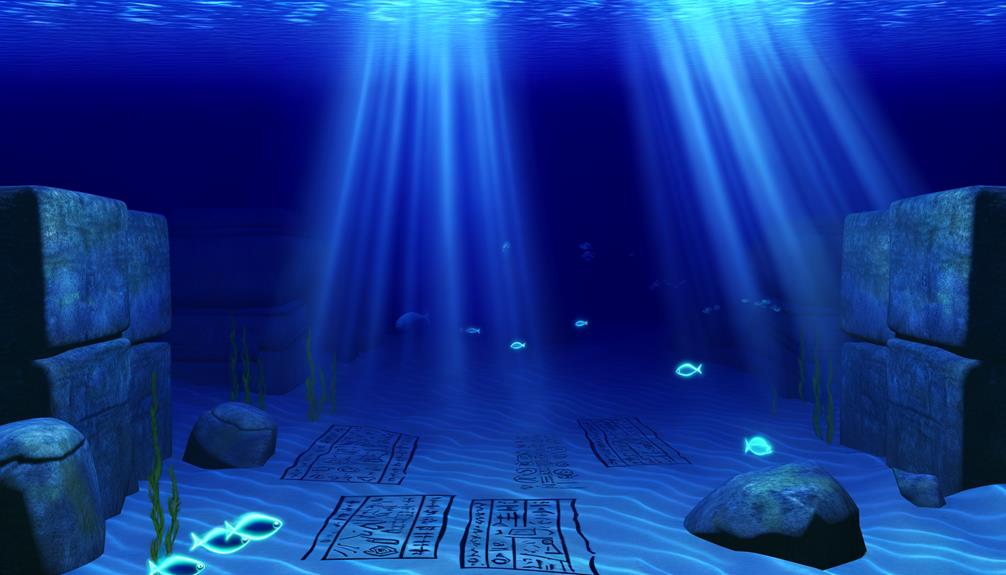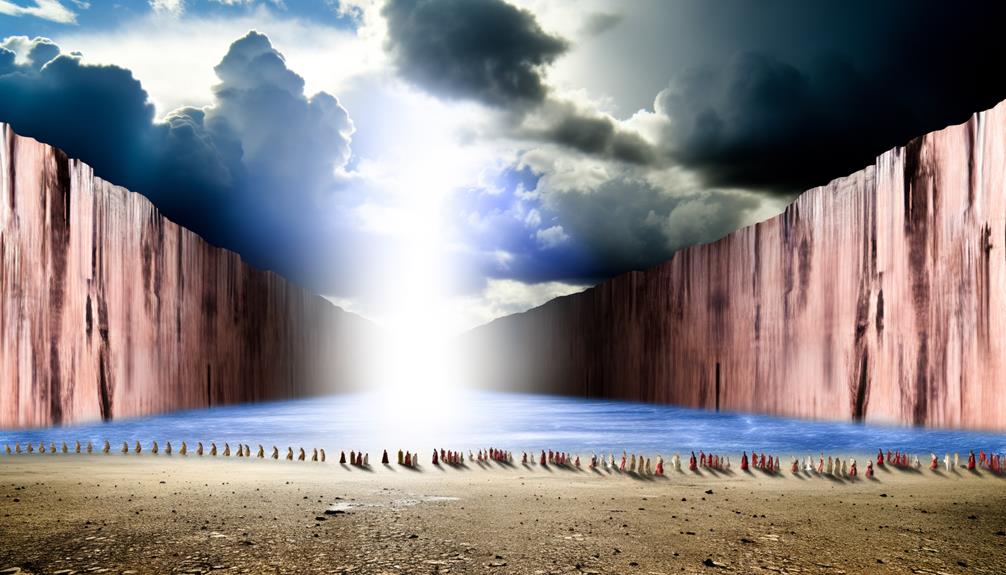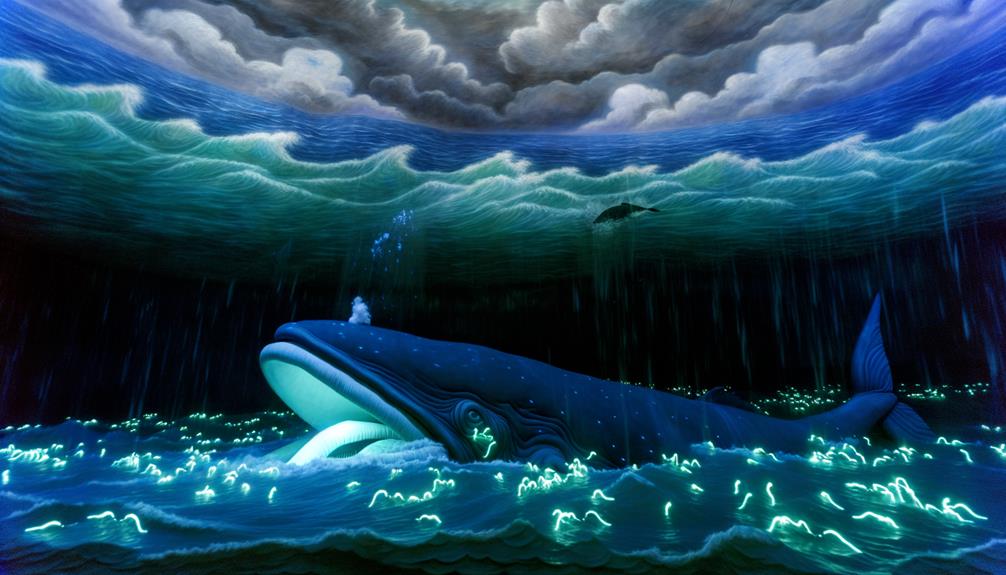Deep Waters Meaning in the Bible: Trials, Deliverance
In biblical texts, ‘deep waters‘ symbolize chaos, existential and spiritual turmoil, and the profound necessity for divine intervention. This imagery originates from ancient Near Eastern views where primordial seas embodied disorder.
Biblical narratives such as Noah’s Flood and the Crossing of the Red Sea employ deep waters to depict divine judgment and redemption, illustrating God’s sovereignty in transforming chaos into order. Psalms frequently use this metaphor to reflect human suffering and the hope for divine rescue. This theme of water as a symbol of spiritual journeys is also prominent in the imagery found throughout the scriptures. The “river to the sea verse meaning” captures the essence of transition and deliverance, where flowing waters signify a movement from despair towards salvation. In these narratives, the faithful are reminded that even the most tumultuous waters can lead to a promised land of hope.
The theological significance of ‘deep waters’ encompasses both divine deliverance and the trials that lead to spiritual growth, inviting contemplation on these multifaceted themes.

Deep Waters Meaning in the Bible: Trials, Wisdom, and God’s Deliverance
| Aspect | Details |
|---|---|
| Definition | Vast, deep bodies of water; often overwhelming or mysterious |
| Biblical Mentions | Psalm 69:1-2, Isaiah 43:2, Proverbs 20:5 |
| Symbolic Meaning | Represents trials, danger, or depth of the human heart |
| God’s Role | Offers deliverance and presence through deep waters |
| Spiritual Lesson | Encourages trust in God during overwhelming situations |
Symbolism of Deep Waters

In biblical literature, deep waters often symbolize chaos, danger, and the unknown, reflecting the ancient Near Eastern understanding of the primordial seas as domains of disorder and threat. This symbolic representation finds its roots in the cultural and religious milieu of the ancient Near East, where seas were perceived as uncontrollable and perilous.
Scriptural references, such as in Psalms and Job, frequently employ this imagery to denote existential and spiritual turmoil. The Hebrew Bible’s portrayal of the deep (tehom) underscores a theological narrative in which divine order triumphs over chaos.
Consequently, deep waters serve as a potent metaphor within Biblical exegesis, illustrating the dynamic tension between human vulnerability and divine sovereignty. This symbolism continues to resonate within theological discourse today.
Creation and Chaos

While the motif of chaos in deep waters evokes notions of disorder, the Biblical account of creation distinctly illustrates the divine imposition of order upon this primordial turmoil.
Genesis 1:2 describes the earth as ‘formless and void,’ with darkness over the ‘face of the deep,’ suggesting an initial state of chaos.
However, the Spirit of God moves over the waters, initiating a process of divine structuring.
By God’s command, the chaotic waters are separated, forming the heavens and the earth, thereby transforming disorder into a cosmos marked by harmony and purpose.
This theological narrative underscores God’s sovereignty and creative power, emphasizing the transformation from chaos to order as a fundamental aspect of the divine act of creation.
Noah’s Flood

The narrative of Noah’s Flood serves as a profound theological metaphor for divine judgment and redemption, illustrating God’s capacity to cleanse and renew the world through the overwhelming force of deep waters.
In Genesis 6-9, the floodwaters symbolize both destruction and purification. God, grieved by humanity’s pervasive wickedness, enacts judgment, yet simultaneously offers a redemptive promise through Noah’s covenant.
The ark becomes a vessel of salvation, preserving life amidst chaos. This duality underscores the depth of divine justice and mercy, showing that the waters, while instruments of obliteration, also pave the way for a new creation.
Consequently, the Flood narrative intricately weaves themes of judgment, mercy, and the transformative power inherent in divine intervention.
Crossing the Red Sea

Amidst their escape from Egyptian bondage, the Israelites’ crossing of the Red Sea epitomizes a pivotal moment of divine intervention and deliverance in biblical theology.
This event, described in Exodus 14, symbolizes God’s power to save His people against insurmountable odds. As Moses stretched out his hand, the waters parted, allowing safe passage for the Israelites and subsequently engulfing the pursuing Egyptian army.
Theologically, the Red Sea crossing underscores themes of faith, divine protection, and liberation. It serves as a metaphor for overcoming spiritual and existential struggles, illustrating God’s unwavering commitment to His covenant people.
This miraculous act is celebrated throughout scripture as a cornerstone of Israel’s identity and God’s salvific narrative.
Jonah and the Whale

The narrative of Jonah and the Whale offers a profound exploration of Jonah’s divine mission, serving as a rich tapestry of symbolic meaning.
The whale, as an instrument of God’s will, encapsulates themes of judgment, mercy, and redemption.
Through Jonah’s journey, the text imparts critical theological lessons about obedience, repentance, and the boundless nature of divine compassion.
Jonah’s Divine Mission
Jonah’s divine mission, characterized by his initial reluctance and subsequent ordeal inside the belly of a great fish, serves as a profound exploration of obedience and repentance in the biblical narrative.
Jonah’s initial refusal to heed God’s command to prophesy against Nineveh highlights human frailty and resistance to divine will.
The narrative progresses to depict his forced introspection within the deep waters of the fish’s belly, symbolizing a transformative period of contrition and spiritual awakening.
Jonah’s ultimate compliance underscores the necessity of aligning human action with divine instruction.
This episode encapsulates a theological paradigm wherein personal crises become catalysts for profound spiritual renewal, emphasizing the inexorable link between divine retribution, human repentance, and eventual redemption.
Symbolism of the Whale
In biblical exegesis, the whale that swallows Jonah is often interpreted as a multifaceted symbol of divine intervention, judgment, and mercy.
Theologically, the whale represents God’s sovereign power to redirect human actions and intentions, highlighting His omnipotence. The act of being swallowed reflects divine judgment, a consequence of Jonah’s initial disobedience to God’s command.
However, the subsequent preservation and deliverance of Jonah from the whale’s belly symbolize divine mercy and the possibility of redemption. This narrative underscores the tension between divine justice and compassion, illustrating that even in the depths of despair, God’s providence remains active.
Consequently, the whale serves as a profound emblem of God’s ability to use extraordinary means to fulfill His divine purposes.
Lessons From Jonah’s Journey
Frequently, Jonah’s journey encapsulates profound theological lessons on obedience, repentance, and divine mercy.
The narrative demonstrates the consequences of defying divine instructions, as Jonah’s initial disobedience leads to perilous circumstances, symbolized by the tempestuous sea and his subsequent engulfment by the great fish.
His time in the deep waters becomes a crucible for repentance, where Jonah’s earnest prayer signifies a turning point.
In addition, the episode underscores God’s boundless mercy, not only in sparing Jonah but also in extending grace to the repentant Ninevites.
This multilayered story therefore invites readers to contemplate the dynamics of human fallibility and divine compassion, illustrating that redemption is accessible through sincere contrition and alignment with divine will.
Psalms and Deep Waters

The Psalms frequently employ the imagery of deep waters to symbolize overwhelming emotional turmoil and existential distress, reflecting the human condition’s frailty and vulnerability.
This metaphor serves not only to illustrate the profound depths of human suffering but also to highlight a recurring theme of divine rescue and deliverance.
Analyzing these passages reveals a complex interplay between human despair and the steadfast hope in God’s salvific intervention.
Symbolism in Psalms
Within the Psalms, deep waters often serve as a potent metaphor for overwhelming distress and divine deliverance, reflecting the psalmists’ profound emotional and spiritual struggles.
For instance, Psalm 69:2 states, ‘I sink in deep mire, where there is no foothold; I have come into deep waters, and the flood sweeps over me.’ Here, deep waters symbolize the inescapable trials faced by the psalmist, invoking a sense of engulfment and helplessness.
Conversely, Psalm 18:16 illustrates divine rescue: ‘He reached down from on high and took hold of me; he drew me out of deep waters.’
Theologically, these passages underscore the dichotomy of human vulnerability and God’s redemptive power, offering hope amidst adversity.
Emotional Turmoil Depictions
Emotional turmoil in the Psalms is vividly depicted through the metaphor of deep waters, illustrating the profound psychological and spiritual anguish experienced by the psalmists. This powerful imagery serves to convey the depth of despair and the overwhelming nature of their struggles.
Key aspects include:
- Psalm 69:1-2 – The psalmist cries, ‘Save me, O God, for the waters have come up to my neck. I sink in deep mire, where there is no foothold.’
- Psalm 130:1 – ‘Out of the depths I cry to you, O Lord,’ emphasizes the desperation and need for divine intervention.
- Psalm 42:7 – ‘Deep calls to deep at the roar of your waterfalls; all your breakers and your waves have gone over me,’ reflecting unrelenting distress.
Divine Rescue Themes
Amidst the profound emotional turmoil conveyed through the metaphor of deep waters, the Psalms also highlight themes of divine rescue, portraying God as a deliverer who reaches into the depths to save those in distress.
This duality underscores the Psalms’ theological richness, where despair and hope coexist. The imagery of God rescuing from “mighty waters” (Psalm 18:16) and “deep waters” (Psalm 69:14) epitomizes His omnipotence and compassion.
| Psalm | Verse Example |
|---|---|
| Psalm 18 | “He reached down from on high and took hold of me; He drew me out of deep waters.” |
| Psalm 32 | “You are my hiding place; You will protect me from trouble.” |
| Psalm 69 | “Rescue me from the mire, do not let me sink…” |
| Psalm 93 | “Mightier than the thunder of the great waters…” |
| Psalm 144 | “Reach down your hand from on high; deliver me…” |
This table elucidates specific verses, illustrating God’s redemptive intervention.
Jesus Calms the Storm

The narrative of Jesus calming the storm, found in the Synoptic Gospels, serves as a profound theological illustration of divine authority over the natural order. This event, wherein Jesus rebukes the winds and the waves, underscores several critical theological themes:
- Divine Authority: Jesus’ command over the storm reflects His sovereignty, affirming His divine nature.
- Faith and Fear: The disciples’ fear juxtaposed with Jesus’ calmness highlights the transformative power of faith.
- Messianic Identity: The miracle signifies Jesus’ identity as the Messiah, who has control over creation.
These elements collectively illustrate how ‘deep waters’ metaphorically represent life’s tumultuous challenges, over which divine intervention can bring peace and order, reinforcing core biblical principles.
Baptism and Renewal

In Christian theology, baptism symbolizes a profound spiritual cleansing and the renewal of one’s covenant with God. This sacrament, often performed through immersion in water, signifies the washing away of sin and the rebirth into a life of faith.
The Apostle Paul articulates this in Romans 6:4, stating, ‘We were thus buried with him through baptism into death in order that, just as Christ was raised from the dead… we too may live a new life.’
The imagery of deep waters represents the transformative journey from spiritual death to resurrection. The act of emerging from the waters embodies a new creation, echoing 2 Corinthians 5:17, “Consequently, if anyone is in Christ, the new creation has come: The old has gone, the new is here!”
Trials and Tribulations

The metaphor of deep waters in the Bible often symbolizes the trials and tribulations that individuals face, reflecting the profound challenges that test one’s faith.
Examples abound, from Job’s relentless suffering to the Israelites’ perilous journey through the Red Sea, each narrative illustrating the crucible of adversity.
Through these experiences, the biblical text underscores a central theological tenet: steadfast faith amidst adversities is integral to spiritual growth and divine reliance.
Biblical Examples of Suffering
Demonstrating the profound intersection of human experience and divine purpose, the Bible recounts numerous instances where individuals undergo severe trials and tribulations. These narratives are not merely historical accounts but are theological constructs that reflect deeper spiritual truths.
- Job’s Ordeal: Job’s narrative epitomizes undeserved suffering, where he loses his wealth, health, and family, yet his faith remains a focal point.
- Joseph’s Betrayal: Sold into slavery by his brothers, Joseph endures imprisonment and false accusations, ultimately rising to a position of power in Egypt.
- David’s Persecution by Saul: David, anointed to be king, faces relentless pursuit by Saul, symbolizing trials faced by those chosen by God.
These examples elucidate the multifaceted dimensions of suffering within the biblical context.
Faith Amidst Adversities
Amidst the throes of trials and tribulations, faith emerges not merely as a passive attribute but as an active, dynamic force that sustains and transforms the believer.
Within the biblical narrative, faith is often depicted as the unwavering trust in God’s providence and sovereignty, even when confronted with profound suffering. This theological construct finds its roots in verses such as James 1:2-4, where endurance through hardships is portrayed as a means of spiritual maturation.
The role of faith during adversities underscores a critical understanding: it is not the absence of trials that defines a believer’s journey, but rather the steadfast reliance on divine guidance and strength.
Consequently, faith amidst adversities becomes a demonstration of the enduring hope anchored in God’s eternal promises.
Divine Protection

Biblical references to deep waters often symbolize God’s omnipotent protection, illustrating His ability to safeguard His followers through life’s most turbulent challenges. This metaphor is profoundly demonstrated in various scriptures, each underscoring the divine assurance provided to believers.
- Exodus 14:21-22: The parting of the Red Sea exemplifies God’s protective power, allowing the Israelites to escape from Egyptian oppression.
- Psalm 69:1-2: David’s plea for deliverance from deep waters highlights trust in divine rescue amidst overwhelming adversity.
- Isaiah 43:2: This verse reassures believers that passing through deep waters, symbolic of trials, will not lead to harm, as God accompanies them.
These passages collectively affirm that divine protection is a cornerstone of faith, offering solace and security.
Spiritual Transformation

The imagery of deep waters not only illustrates divine protection but also serves as a powerful symbol of spiritual transformation, reflecting the profound inner changes that occur when individuals encounter and surmount life’s profound challenges with faith.
In biblical texts, deep waters often signify the process of purification and renewal. This spiritual transformation involves a reawakening and realignment of one’s soul with divine purpose, fostered by enduring trials and emerging strengthened in faith.
| Symbolism | Spiritual Implication |
|---|---|
| Deep Waters | Purification and Renewal |
| Surmounting Challenges | Strengthened Faith |
| Divine Encounter | Realignment with Divine Purpose |
Through these trials, individuals experience a deeper connection with God, emerging transformed and fortified in their spiritual journey.
Conclusion
In biblical symbolism, deep waters serve as a multifaceted metaphor, embodying both creation and chaos, exemplified in narratives such as Noah’s Flood and the crossing of the Red Sea.
These waters signify not only divine judgment and trials but also protection and spiritual renewal, as seen in Jonah’s ordeal and the sacrament of baptism.
Consequently, deep waters encapsulate the journey of faith: from tribulation to transformation, from perils to divine providence, painting a vivid tapestry of spiritual odyssey.






